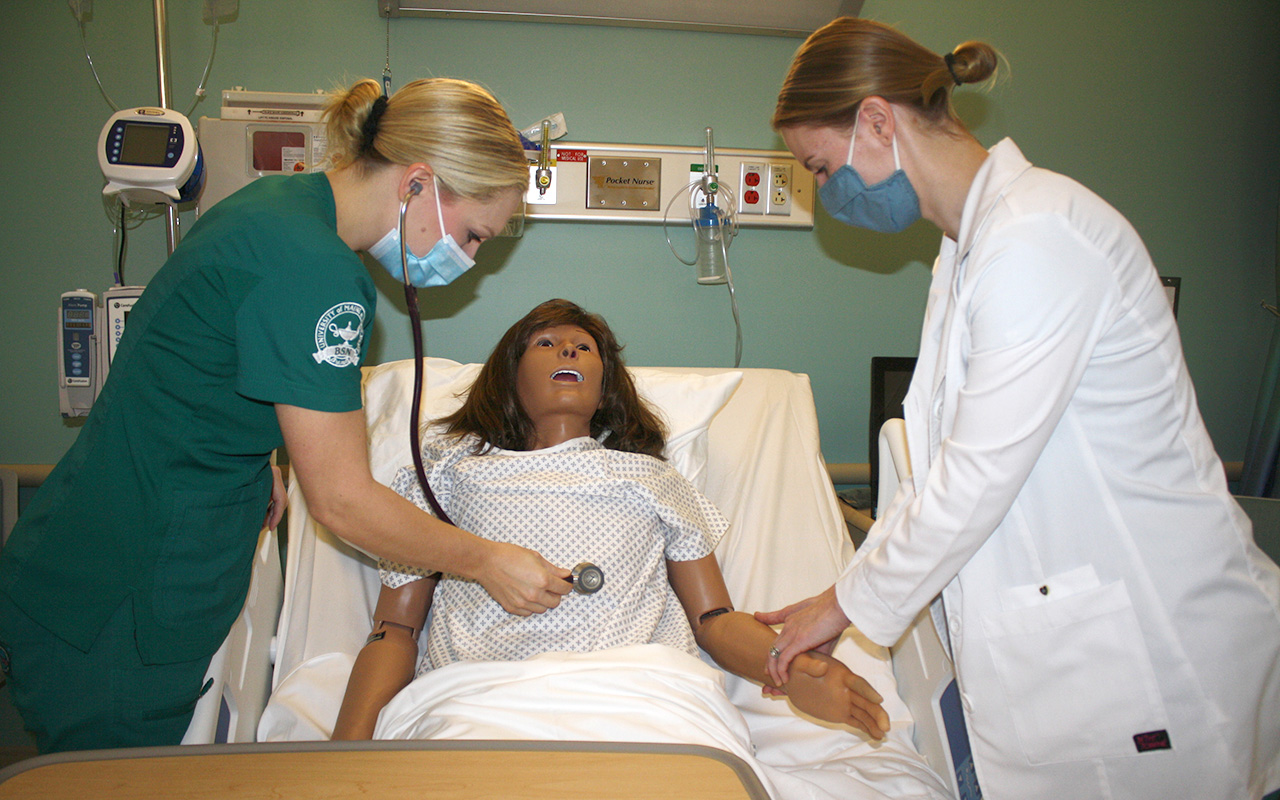
PRESQUE ISLE, Maine — On an average day in class, University of Maine at Presque Isle nursing students Rachel Stetson and Sarah Sutherland check patient vital signs and heart beats, ask patients how they are feeling and perform quick interventions during health emergencies.
For students like Stetson and Sutherland, there is one major difference between working in UMPI’s new nursing simulation center and an actual hospital. At UMPI their “patients” are mannequins designed to look and behave like real people.
“It gives you a feel for what it’s like to actually perform different skills [of a nurse] and intervene when necessary,” Stetson, a junior nursing student from Mars Hill, said.
All students who train in the simulation center are part of UMPI and the University of Maine at Fort Kent’s nursing program collaboration, which began serving students in fall 2018. As part of the collaboration, participants are considered UMPI students for their first two years and then become UMFK students their junior year. They complete all their classes and lab work on the UMPI campus.

UMPI nursing students Gracie Griffeth (left) and Maranda Anthony take care of a “patient” in the university’s new nursing simulation center. (Melissa Lizotte | The Star Herald)
On Wednesday, Nov. 18, Stetson and Sutherland were one of four pairs of nursing students taking care of “patients” at UMPI’s new John Lisnik Nursing Simulation Center. The center, named after the former University of Maine System liaison to the Maine Legislature, is located in a former lecture hall that was converted into an 1,800-square-foot nursing lab.
UMPI completed the simulation center in time for the fall 2020 semester and funded the renovation through the $49 million UMaine System workforce infrastructure bond that voters passed in 2018.
The space, which replicates a hospital setting, includes a three-bed simulation room with cameras and a control room, a maternity bed and replica mother and baby mannequins and a four-bed nursing lab with classroom space.
Erin Soucy, UMFK dean of undergraduate nursing, said that 75 students are enrolled in nursing classes at the UMPI campus. Though all students begin working in the simulation center during their first year, their most intensive learning experiences occur during their junior and senior years.
“All the equipment simulates what they’ll use in a hospital or other patient care settings,” Soucy said.

UMPI nursing student Kylie Vining (left) holds a mannequin newborn baby in UMPI’s new nursing simulation center while fellow student Shauna Page cares for the baby’s “mother.” (Melissa Lizotte | The Star Herald)
For instance, the maternity ward allows students to simulate live deliveries and respond to complications that arise during childbirth. In the control room, an instructor can record students so that they can learn and improve upon the proper techniques and actions needed for various medical situations.
The collaboration between UMPI and UMFK has benefited numerous students from central Aroostook who wish to pursue their bachelor of science degree in nursing but are unable to travel to Fort Kent for classes.
Sutherland, who lives in Caribou, said she chose to pursue her degree through UMPI and UMFK to attend classes closer to home while still gaining crucial real-life experiences. After graduating, she hopes to work as an operating room nurse at a local hospital.
“I want to help people and give back to my community,” Sutherland said, about her motivations for becoming a nurse.

UMPI nursing student Kelley McIntyre of Caribou practices taking care of a “child” patient using a specialized mannequin. (Melissa Lizotte | The Star Herald)
With the UMPI-based program growing quickly, UMPI and UMFK are looking to expand opportunities for more students in central and southern Aroostook County. Recently, students at Region Two of Applied Technology have been able to earn dual high school and college credits toward their first year of nursing studies. Many NMCC students have transitioned to UMPI after completing their associate’s degree in nursing, Soucy said.
The increased focus on nursing in Aroostook County comes at a time when employment of registered nurses nationwide is expected to grow by 7 percent between 2019 and 2029. Maine is projected to have a shortage of at least 2,700 nurses by 2025.
“Partnering with UMPI has allowed us to expand nursing education to students,” Soucy said. “We want to continue expanding so that more students can stay in Aroostook County after they graduate.”







